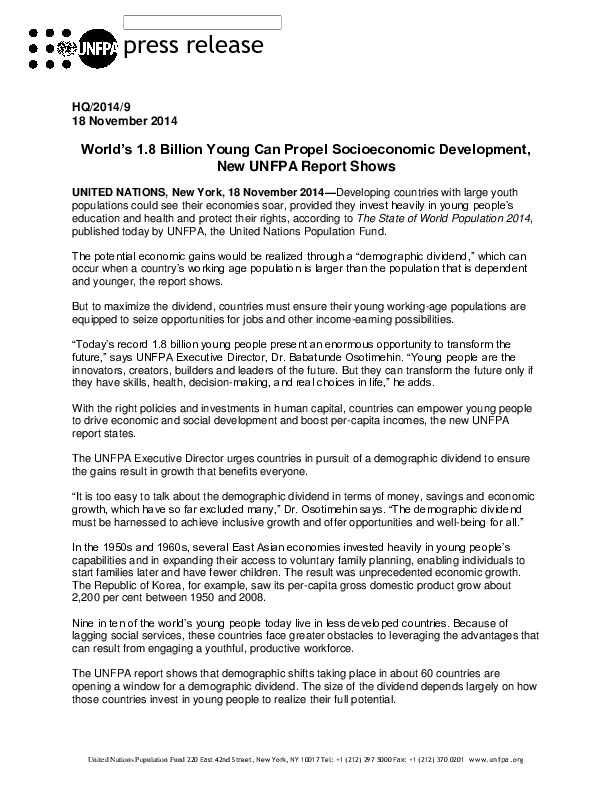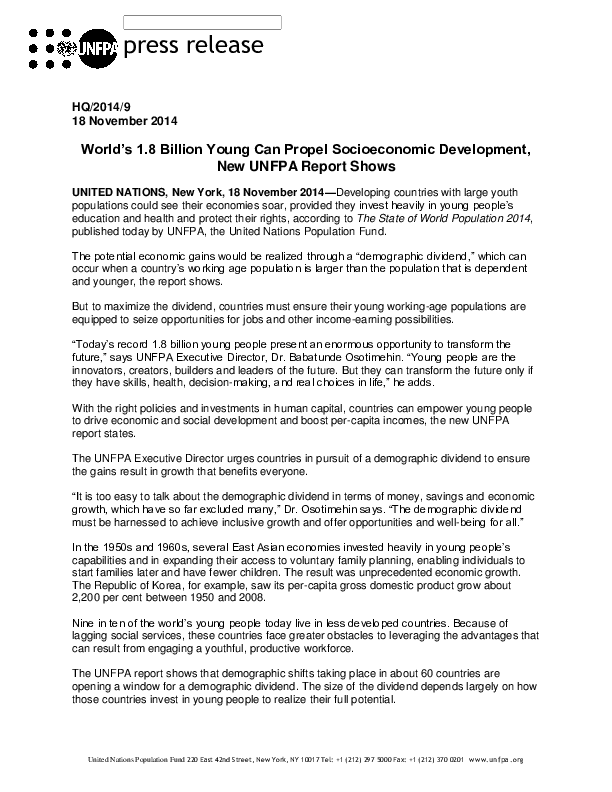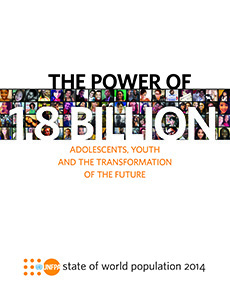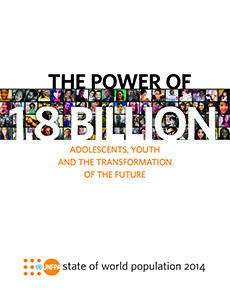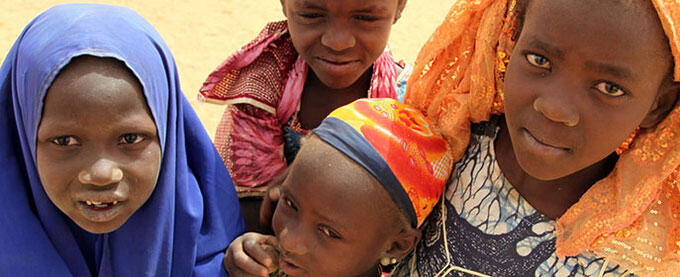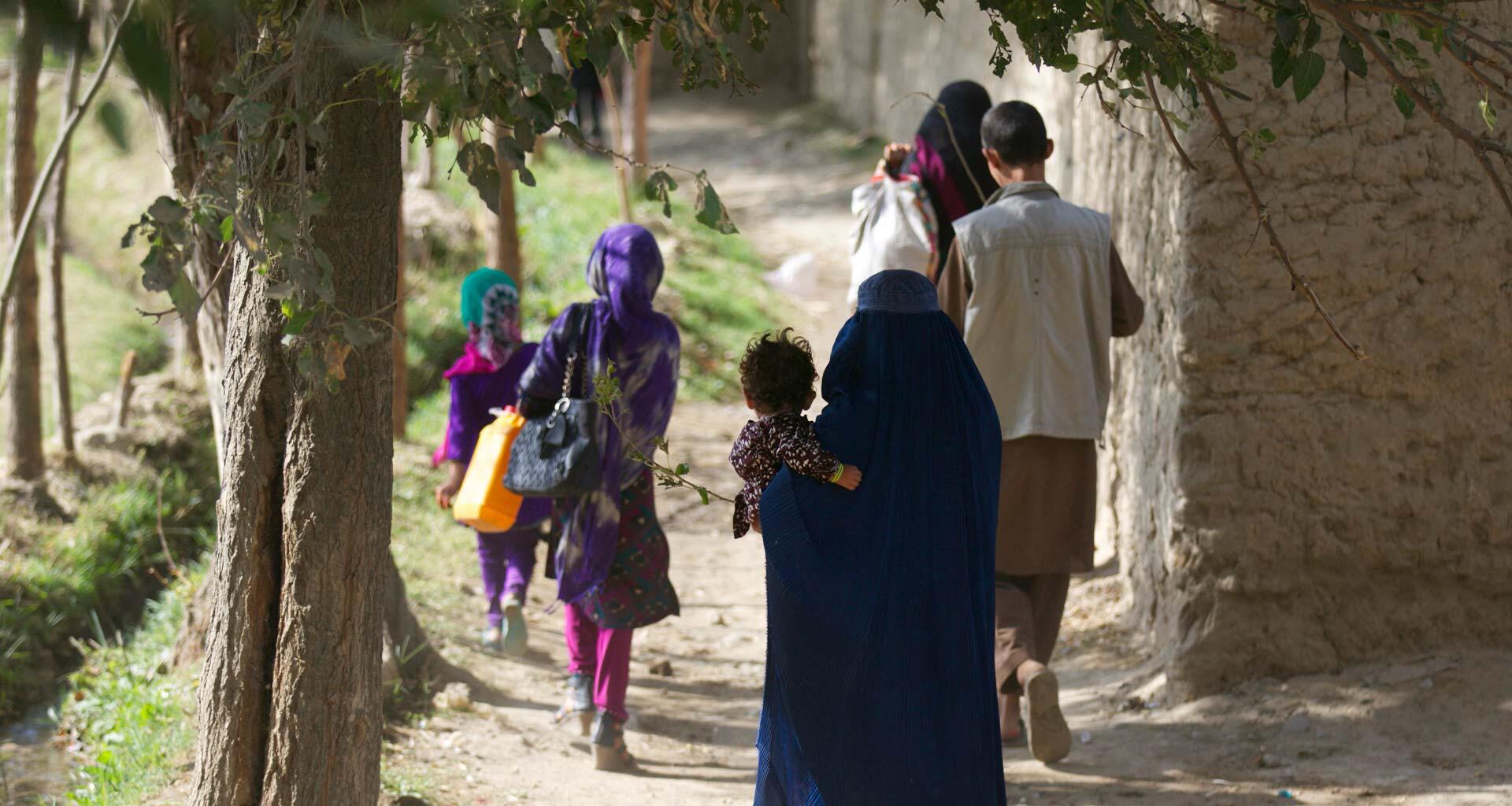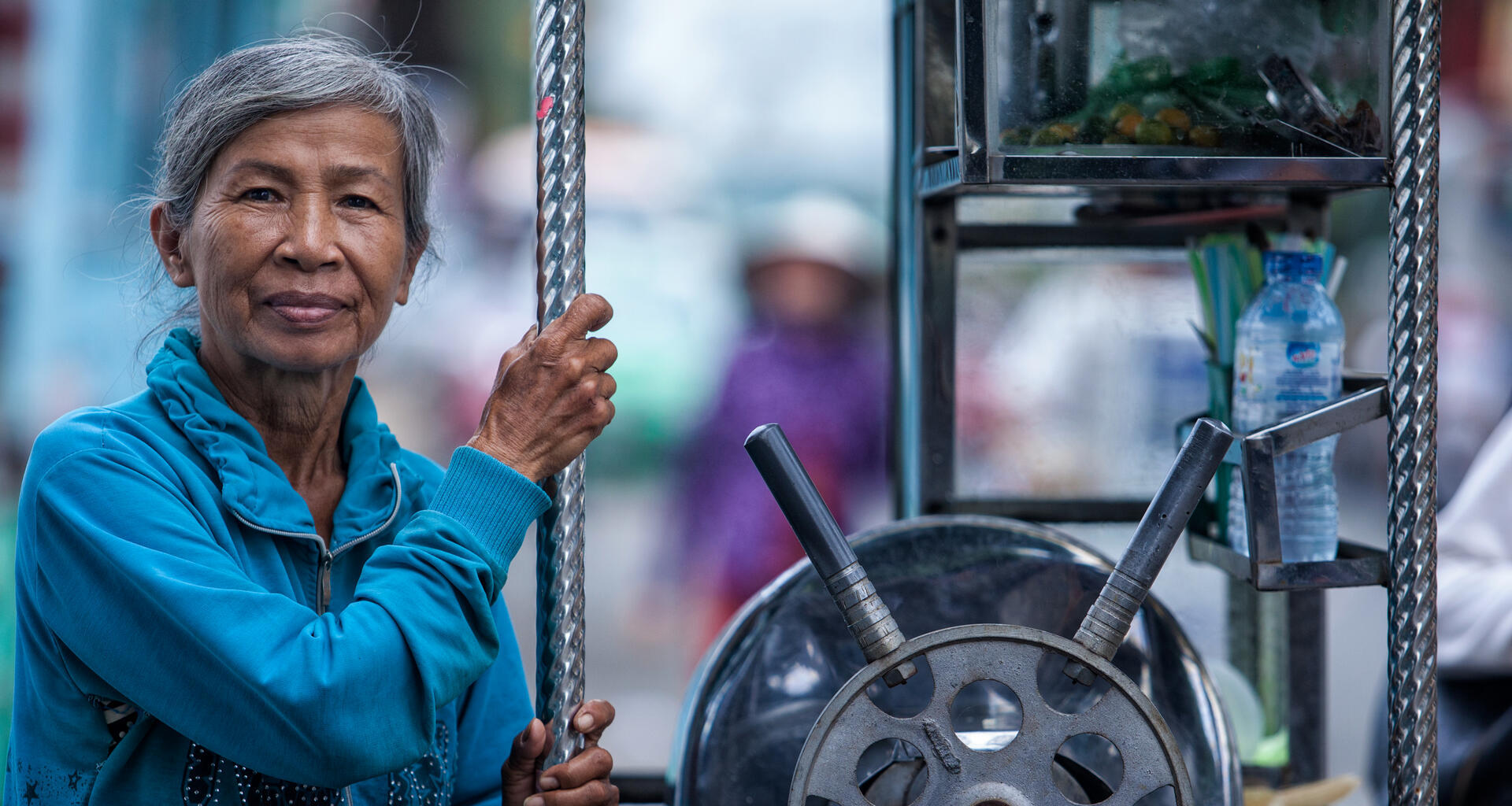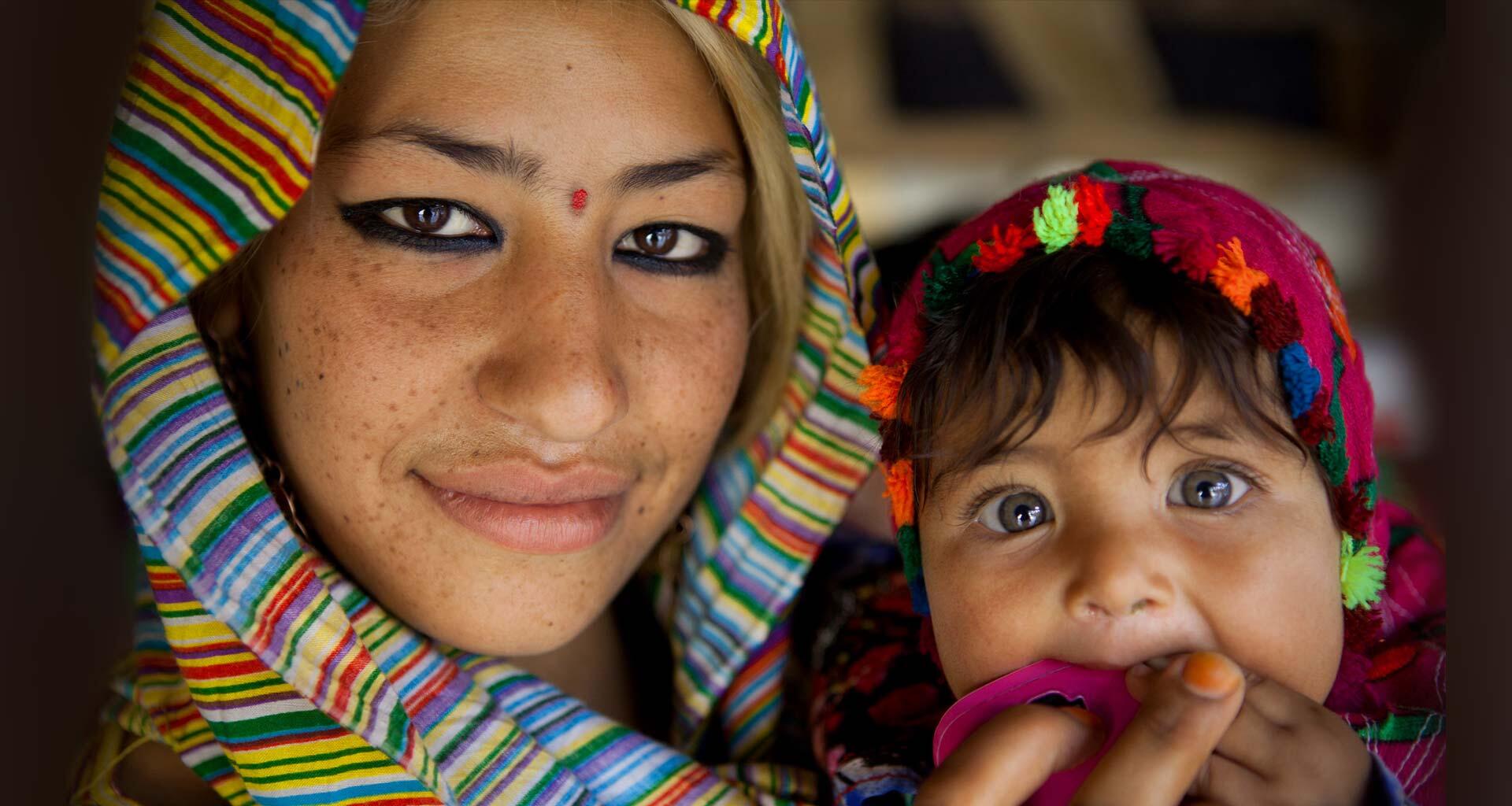Sustainable development cannot be achieved without assuring that all women and men, and girls and boys, enjoy the dignity and human rights to expand their capabilities, secure their reproductive health and rights, find decent work, and contribute to economic growth. Developing policies and investments to secure that future requires that governments know the size, sex, location and age structure of their present and future populations. Countries with the greatest demographic opportunity for development are those entering a period in which the working-age population has good health, quality education, decent employment and a lower proportion of young dependents. Smaller numbers of children per household generally lead to larger investments per child, more freedom for women to enter the formal workforce and more household savings for old age. When this happens, the national economic payoff can be substantial. This is a "demographic dividend."
Necessary investments
Realizing a demographic dividend requires multiple investments. The most essential are building the capabilities of people and ensuring their rights and freedoms to achieve their potential. Young people need the chance to gain the education and experience to succeed in a competitive global workplace, which demands more skills, education and technical expertise than ever before.
Tragically, the chance to realize one's potential is often derailed, particularly for millions of girls, who are pushed from school, subjected to child marriage, early and unplanned pregnancies, poor access to health care and limited education. When large numbers of people find themselves trapped in this trajectory of restricted opportunities, poor health and limited capabilities, there can be no demographic dividend: An age structure with fewer dependents is unlikely to occur, and each person’s ability to develop their capabilities, save and invest, be resilient in the face of crises and take the risk to innovate will be permanently undermined.
The fulfillment of human rights – including sexual and reproductive health and reproductive rights – is therefore essential for any society to achieve a demographic dividend.
History shows there is a real possibility of countries missing their chance at a dividend. The opportunity to reap a demographic dividend occurs during a finite window that gradually closes as the working generation ages. For example, the late twentieth century saw a demographic dividend in Asia. Gross domestic product increased sevenfold, an economic boom described as the “Asian economic miracle.” However, in Latin America around the same time, growth was only twofold, reflecting unequal access to investments in education and health, including the reproductive health and rights of women and girls.
What it takes
Achieving a demographic dividend requires that each country understand the size and distribution of its population, its current and projected age structure, and the pace of population growth. A growing number of analytic tools are available for such “population assessments,” shortening the time and resources needed for a situation analysis of national circumstances. National needs must be matched to a sequence of short- and medium-term investments that assure the rights of all young people to plan their lives, be free of violence and trauma, be assured of essential freedoms and reproductive rights, and have access to quality education and mentoring.
Dividends will be constrained without simultaneous investments in decent job creation, good governance, infrastructure and a functioning business climate. But all progress will be constrained if the population is under-prepared, and every person – particularly every girl – cannot pursue her education or navigate her transition to adulthood assured of her human rights.Such assurance includes the freedom to decide when and whom to marry, the timing and number of her children, and the security to balance work and family life.
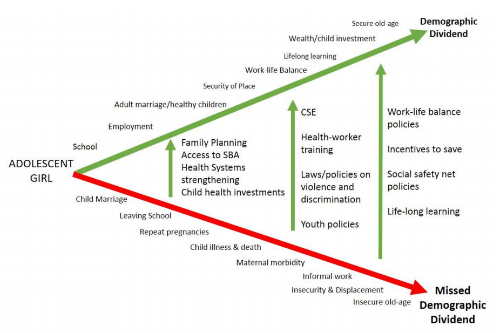
What is UNFPA doing?
The rights and dignity of all people lie at the heart of development. This is why UNFPA, works to help countries realize the International Conference on Population and Development Programme of Action, which links investments in each person to sustainable development.
Strategic assessment
UNFPA offers a growing package of tools to help countries rapidly characterize their populations based on census and population surveys, including age-structure patterns and projections, current rates of child marriage, unmet need for family planning, coverage and access to sexual and reproductive health and rights, and sex differentials in schooling, among other factors.
The Fund also supports national policy reviews on relevant legislation and national action plans. These include status and enforcement of laws on child marriage, protection of women’s rights, and youth policies, which form the basis of policy guidance on the investments needed for a demographic dividend.
UNFPA also provides clear guidance on the “multiplier effects” of investments and how support for the rights and capabilities of young people will help achieve the Sustainable Development Goals in an actionable and results-oriented way.
Building Human Capital
UNFPA works with countries to help fulfill the rights of women and adolescent girls and to support their participation in school decision-making. UNFPA also partners with countries to deliver the sexual and reproductive health information and services that can contribute to a demographic dividend. These include programmes for youth empowerment; improvements in maternal, newborn and child health; universal access to contraception; prevention and treatment of HIV and sexually transmitted infections; and the elimination of gender-based violence and harmful practices such as child marriage.
Essential Partnerships
The Fund has a long, historic presence in many countries around the world, resulting in strong partnerships and long-term capacity-building of national institutions. Few UN agencies operate across the development spectrum in the manner of UNFPA, allowing it to bring together partners at all levels (including the International Labor Organization, the President of the General Assembly, United Nations Department of Economic and Social Affairs, and the World Economic Forum, to name a few), to advocate for investments both globally and within countries.
Last updated on 5 May 2016
Latest
Publications
State of World Population 2014
Pagination
Working-age population, 2018
This map shows the share of each country’s population that is between the ages of 20 and 64 – working age.
Source: United Nations, Popular Division, World Population Prospects: 2017 revision; World Bank, World Development Indicators; and ILO, ILOSTAT.
Note: Gross Domestic Product (GDP) per capita is expressed in constant 2010 US$. Labour productivity is expressed in constant 2011 international $ in Purchasing Power Parity (PPP) terms. An international dollar has the same purchasing power as the U.S. dollar has in the United States. A PPP exchange rate is the number of units of a country’s currency required to buy the same amounts of goods and services in the domestic market as a U.S. dollar would buy in the United States.
Please select country for detailed view
Share of population aged 20-64
Select country from map or menu
Source: United Nations, Popular Division, World Population
Prospects: 2017 revision; World Bank, World Development Indicators; and ILO, ILOSTAT.
*Note: Gross Domestic Product (GDP) per capita is expressed in constant 2010 US$. Labour productivity is expressed in constant 2011 international $ in Purchasing Power Parity (PPP) terms. An international dollar has the same purchasing power as the U.S. dollar has in the United States. A PPP exchange rate is the number of units of a country’s currency required to buy the same amounts of goods and services in the domestic market as a U.S. dollar would buy in the United States.
